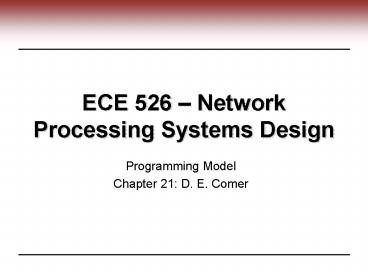ECE 526 Network Processing Systems Design
1 / 21
Title:
ECE 526 Network Processing Systems Design
Description:
Network processors is complicated and heterogeneous architecture ... Might make use of Intel's Action Service Libraries. Micro ACE. ACE with two components: ... –
Number of Views:55
Avg rating:3.0/5.0
Title: ECE 526 Network Processing Systems Design
1
ECE 526 Network Processing Systems Design
- Programming Model
- Chapter 21 D. E. Comer
2
Overview
- Recalled
- Network processors is complicated and
heterogeneous architecture - Hard to program it
- Need understand fine details of architecture
- Current approach assembly or subset of C language
- Programming Model
- Filling the gap between application and
architecture - Natural interface (e.g. domain-specific language
for programmer) - Abstraction of underlying hardware
- Enough architecture details to write efficient
code - Not too complicated for programmer
- Two models
- Hardware specific model IXP Programming Model
- General Models NPClick and ADAG
3
IXP Programming Model
- What kind of software abstractions are used on
IXP? - Active Computing Element (ACE)
- Fundamental software building block
- Used to construct packet processing system
- Runs on XScale, uE, host
- Handles control plane and fast or slow path
packet processing - Coordinates and synchronizes with other ACEs
- Can have multiple outputs
- Can serve as part of pipeline
- Protocol processing is implemented by combining
multiple ACEs
4
ACE Terminology
- Library ACE
- ACE that has been provided by Intel for basic
functions - Conventional ACE or Standard ACE
- ACE build by customer
- Might make use of Intels Action Service
Libraries - Micro ACE
- ACE with two components
- Core component (runs on XScale)
- Microblock component (runs on uE)
- Terminology for microblocks
- Source microblock initial point that receives
packets - Transform microblock intermediate point that
accepts and forwards packets - Sink microblock last point that sends packets
5
ACE Parts
- An ACE contains four conceptual parts
- Initialization
- Initialization of data structures and variables
before code execution - Classification
- ACE classifies packet on arrival
- Classification can be chosen or use default
- Actions
- Based on classification an action is invoked
- Message and event management
- ACE can generate or handle messages
- Communication with another ACE or hardware
6
ACE Binding
- ACE can be bound together to implement protocol
processing - Binding happens when loading ACE into NP
- Binding can be changed dynamically
- Unbound targets perform silent discard
7
ACE Division
8
Microengine Assignment
- Packet processing involves several microblocks
- How should microblocks be allocated to
microengines? - One microblock per micorengine
- Multiple microblocks per microengine (in
pipeline) - Multiple pipelines on multiple microengines
- What are pros and cons?
- Passing packets between microengines incurs
overhead - Pipelining causes inefficiencies if blocks are
not equal in size - Multiple blocks per microengine causes contention
and requires more instruction storage - Intel terminology microblock group
- Set of microblock running on one microengine
9
Microblocks Groups
- Microblock groups can be replicated to increase
parallelism
10
Microblock Group Replication
- Performance Critical Groups can be replicated
11
Control of Packet Flow
- Packets require different processing blocks
- IP requires different microblocks than ARP
- Special packets get handed off to core
- Dispatch Look control packet flow among
microblocks - Each thread runs its own dispatch loop
- Infinite loop that grabs packets and hands them
to microblocks - Return value from microblock determines the next
step - Invocation of microblockis similar to function
call
12
Dispatch Loop
- Example
- Three microblocks
- Ingress, IP, egress
13
Click Model of IPv4
- NP-Click A Programming Model for the Intel
IXP1200 by Niraj Shah and etc, UC Berkeley
14
My Approach ADAG
- Architecture-independent workload representation
- ADAG (Annotated Directed Acyclic Graph)
- Node processing task
- 3-tuple the number of instructions, the number
of memory reads and writes. - Edge the dependency
- edge weight the amount of data communicated
between nodes.
15
Profiling Trace Generation
- PacketBench Ramaswamy 2003
- Data dependencies between registers and memories
- Control dependency for conditional branch
16
Clustering Algorithm
- Ratio Cut Wei 1991
- identify the natural cluster without a-priori
knowledge of the final number of clusters - cluster nodes together such that rij is minimized
- top down approach
- NP-complete
- MLRC (Maximum Local Ratio Cut)
- bottom-up
- merge the nodes that should be least separated
and recursively apply the process - computation complexity O(n3)
17
ADAG Mapping onto NPs
- Goal to generate a high performance schedule
- Mapping is NP-complete problem
- Using randomized mapping to solve this
NP-complete - Evaluate the randomized mapping by an analytical
performance model - B. A. Malloy, E. L. Lloyd, and M. L. Souffa.
Scheduling DAGs for asynchronous multiprocessor
execution. IEEE Transactions on Parallel and
Distributed Systems, 5(5)498508, May 1994.
18
Mapping Quality I
- Simulation setup pipeline depth 1, width 8.
- Performance model of ideal mapping
19
Mapping Quality II
- Exhaustive search enumerates all possible
mappings - Randomized search randomly chooses a mapping
20
Summary
- NP programming for high performance is hard
problem - Programming model is solution
- Intel ACE
- NP Click
- ADAGs
21
For Next Class and Reminder
- Read Chapter 23
- Lab 3
- Project































